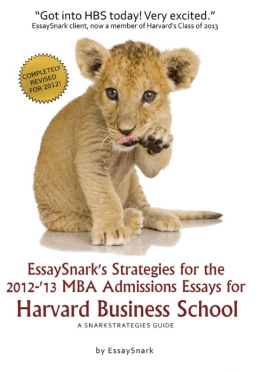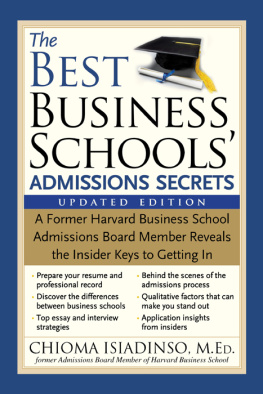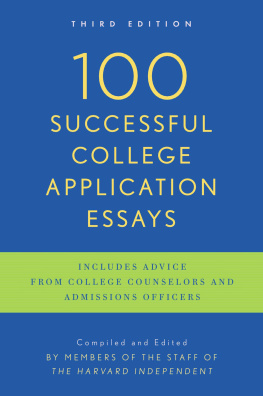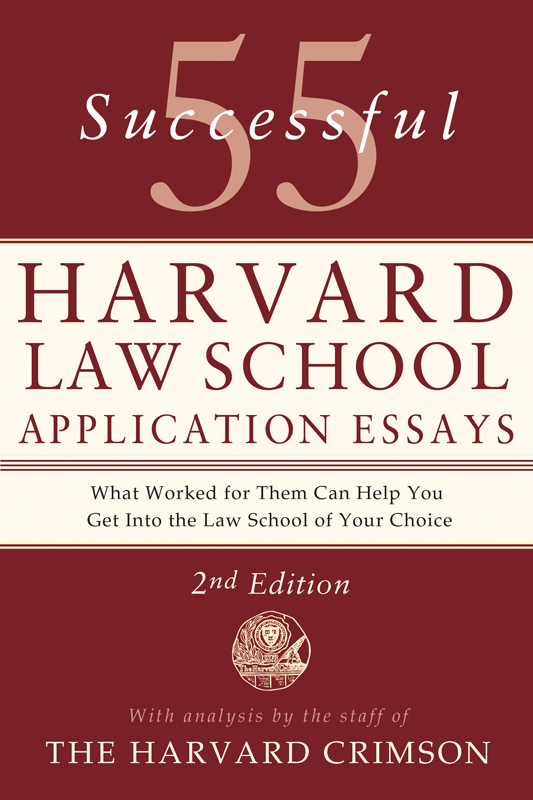Contents
Guide

The author and publisher have provided this e-book to you for your personal use only. You may not make this e-book publicly available in any way. Copyright infringement is against the law. If you believe the copy of this e-book you are reading infringes on the authors copyright, please notify the publisher at: us.macmillanusa.com/piracy.
ACKNOWLEDGMENTS
We at The Harvard Crimson would like to thank all who helped assemble the second edition of this book, including: Samir Gupta, David Liu, and LuShuang Xu, who all spearheaded this books logistics side along with our business manager, Andrew Creamer; Brian Cronin, head of content for the book; Maya Jonas-Silver, who kick-started the essay review process; Matt Martz of St. Martins Press for his guidance and thoughtful edits; the fifty-five Harvard Law students who donated essays so that this books readers might follow their footsteps; and of course the Crimson s editors who penned reviews and ensured this book lived up to the professionalism and quality of our daily, journalistic content.
CONTENTS
INTRODUCTION
When the first edition of this book was released in 2007, a swelling applicant pool marked the primary pressure facing law school applicants. At the time the volume of applications was on its way toward record highs, and enrollment still remains above its 2007 levels, but the elevated competition doesnt end with a letter of admission. The class of 2007 entered a job market to find a 92 percent employment rate for law school graduates. For the class of 2012, the most recent available data set when this book was written, that number dropped to 84 percent, tied for second lowest since 1985. Many students sought shelter in law schools during the recession, a factor that has only increased the employment bottleneck in the downturns wake. And the change hasnt been restricted to quantity. The composition of those jobs has changed, too. In 2007, over three-quarters of graduates found jobs requiring bar passage, i.e., the sort of jobs students attend law school to pursue. For the class of 2012, under two-thirds met that standard. Still more grimly, a mere 56 percentbarely halffound full-time, long-term employment. As recently as the class of 2010 (as far back as the American Bar Associations data extends), that number stood at 70 percent. In todays environment, the premium has risen sharply for the law schools that are still adept at connecting students with future goals. And by extension, the competition for acceptance to those schools has risen, too. In that stark light, the value of an outstanding application to those schools is more vital than ever.
With an application deadline looming, those numbers and pressures might overwhelm you. But dont throw your hands and the book thats in them into the air just yet. Keep reading.
Yes, the application is vital, and no, it isnt effortless, but it offers an excellent opportunity. The law school application brings together several revealing but imperfect glimpses at who you are. Your LSAT score, transcript, rsum, and recommendations all illuminate various aspects of the whole. Your LSAT score points to your reasoning ability and your law school geared skillset with a single, standardized number for helpful comparison across schools. Important as it is, it certainly doesnt secure admission. At most of the top law schools, 25 percent or more of students have LSAT scores below 170. And many reject students with scores well above that. The transcript and rsum both indicate prior experience and success. But the meaning behind college GPA figures varies widely from school to school, and even more so across majors and classes. And a range of unseen circumstances, from personal life to extracurriculars, can affect it from semester to semester. Reliance on a single number risks myopia. The rsum touches on your more substantive experiences, but its succinctness saps them of context and meaning. Recommendations begin the vital task of connecting, of drawing together the far-flung strands of academics, motivation, and who you are. Yet they, too, offer only partial snapshotsof you in a single class or subject, and strictly through the lens of the writer.
None of these components amount to enough on their own. No one part is. But you do have a chanceone chanceto offer your own narrative, one way to tie together and relate those important but disparate measurements.
You have a personal statement.
At most upper-echelon law schools, the personal statement is a two-to-three page document with an open-ended prompt. Some schools provide detailed pointers on what they look forworth scrutinizing on a school-by-school basiswhile others opt for more laconic approaches. In either case, the choice core substance for your essay lies with you. As you begin to brainstorm, keep your audience in mind. It isnt your roommate, it isnt your English professor, and it isnt you yourself. Its a law school admissions officer, one who will read a large batch of similar statements quickly but discerningly. Think of how your essay can tell them something your isolated application parts cant tell, and think of how you can accomplish that in a mere two pages. Think of how youll stand outin a good way.
Crafting the statement is a challenge. Youve lived a life over two decades in length, and you get only a few paragraphs to condense it all the way down to its essence. The temptation to list accomplishments or experiences is a strong one. Some essays try to pack too much and, as a result, reveal too little about the applicant as a person. Dont struggle to compress a lifetime of experiences into one essay. Instead, think of ways to express who you are through your own voice and a focused selection of illuminating experiences. The specific content of those experiences vary widely from applicant to applicant. You might have a challenge you met and overcame, whether throughout your early life or during the past summer. You might have an encounter that helped you learn and grow. You might have a passion youve followed for years. Whatever you choose, it should speak to who you arenot who your impressive best friend is or what Teach For America does or how much your mother overcame as a child. Ask yourself the question: What does this say about me? A good personal statement is just that, a profoundly personal look at the applicant behind the application.
Because the application essay presents such a personal exercise, no single set of steps can guide you through it. This book isnt an instruction manual. It doesnt lay out a precise formula or grand theory for you to follow. Youll find other guides that profess to hand you a comprehensive set of rules and procedures. But if youre pursuing acceptance to a law school, and if youve picked up this book, chances are you dont need a rigid script aimed at the lowest common denominator. Chances are that a cookie-cutter approach will only relegate your essay to the ho-hum middle of a dense, competitive pack. But you can benefit by analyzing, understanding, and internalizing the pasts proven routes to success.
55 Successful Harvard Law School Application Essays is composed of a variety of successful essays for you to learn and draw from. On an individual basis, each essay provides just one perspective, but taken as a whole, this book will help you understand how to form an essay both personal and compelling. Every essay in this book secured an author admission to Harvards top-ranked Law School. While all authors naturally had strong application components beyond the personal statement, weve selected these essays because they represent the sort of superior writing and thinking that contributes to admissions success. The writers and their stories are sui generis so dont worry if youve never founded a tech start-up or battled tsunamis in Samoabut many of their effective writing techniques and approaches are universal. Dont focus on the particulars of a writers experiences or feelings and dont measure yourself against them. Focus on how they expressed their experiences effectively and won over the admissions officers who read them.






